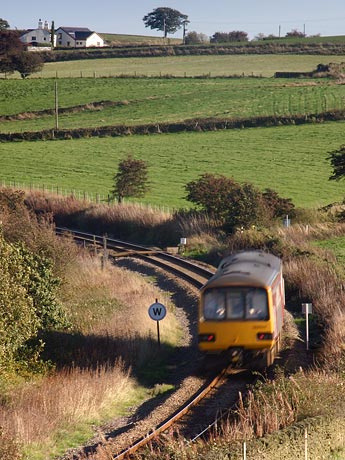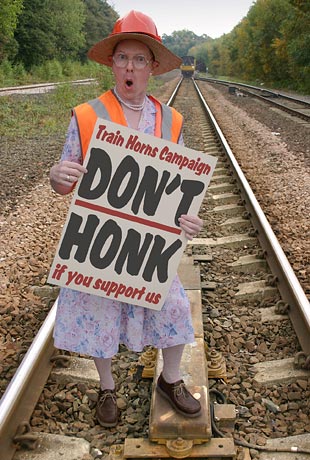|
So now we know. Don’t bother developing a robust rationale next time you want the rules changed - just stir-up a press campaign, secure the support of your MP and threaten legal action. That’s the route to success taken by our neighbours in Suburbia who’ve spent the last four years making one hell of a racket about train horns. Tonight all is quiet and ‘disgusted of Tunbridge Wells’ sleeps soundly once again.
Since early April, the noise nuisance near whistle boards has been soothed by a night-time curfew. Not great news for those staggering home from the pub over Carr Head Farm crossing (pictured below) with its blind curve. Network Rail continues an assessment of problem sites with a view to removing boards. There’s also a reissued standard mandating lower minimum sound levels, but only for new or modified horns.
Out on track, that distant hoot is hugely reassuring. He’s seen you, you’ve seen him. Just for a moment, the disconnected worlds of driver and trackworker come together. As rain drips from your hardhat, a genial wave conveys his condolences.
Although there are no stated plans to remove it, there’s little doubt in my mind that this courtesy is living on borrowed time, certainly as far as orange jackets are concerned. In theory it’s irrelevant - you can’t rely on it as part of a safe system. It’s a different story though in practice - I’ve been thankful for a driver’s diligence on more than one occasion. Whilst working alone, it’s far too easy to become engrossed in your work.

The railway’s ‘rapid’ response to public uproar was masterminded by the Train Horns Steering Group. Who comes up with these titles? Trouble is, April’s changes are seen as a fudge. One MP wants horns to be silenced during daytime as well. Meanwhile the Noise Abatement Society, having engaged with our “painfully slow and ponderously careful decision-making mechanism”, strongly objects to the removal of whistle boards and believes drivers should sound their horn whenever it’s deemed necessary, even at night. The NAS seems more uneasy about the safety implications than we do.
|
| The NAS seems more uneasy about the safety implications than we do. |
|
This sorry mess is entirely of the railway’s own making. The typical minimum sound ‘pressure’ for a horn, when measured from 5 metres in front of a train, was set at 120dB back in the Eighties. Often regarded as the threshold of pain, this is equivalent to standing 60 metres from a jet engine at takeoff.
It must be fair to surmise that older trains consistently fall short of this standard, intended to ensure that they can be heard at least quarter-of-a-mile away. Only when modern units were introduced on the Brighton line in 2003 was the peace truly shattered. Their horns, according to incensed locals, are twice as loud as those on the old slam-doors.
Two years ago, lower levels were introduced. Inexplicably, the upper limit was removed altogether, replaced by an advisory one - a classic case of buck-passing. To reduce environmental impact, it was even recommended that the intensity should be suppressed by 5dB when experienced from the side. A sensible idea you might think, except no-one bothered to check if it was technically feasible. It wasn’t so that’s now been withdrawn.

Like ‘Life on Mars’, we’ve turned the clock back to the Seventies - a time when common sense prevailed, not pundits from distant planets. Ear-splitting blasts should gradually fade as a mandatory ceiling has also been restored. But a resident of Sittingbourne, who claims that her garden has been a no-go area thanks to the deafening blight of today’s rolling stock, hits the nail on the head - “lowering the volume of the horn is the only answer”. Of course it is. So are we going to act retrospectively? No, that’s deemed too expensive. Why not just put a sock in it?
Over four years, our experts have steered a circuitous course, taking in risk models, research projects and a dalliance with ‘broadband’ technology. Communiqués have been spewed-out like water from a geyser. Uncle Tom Cobley came in for talks. How many horns could have been stifled for the cost of this investment?
Story added 1st June 2007
|